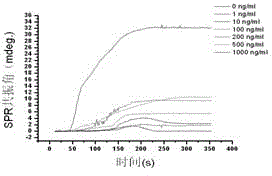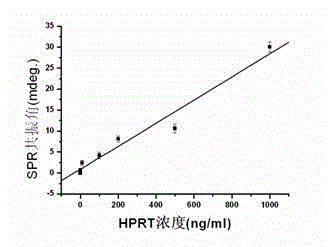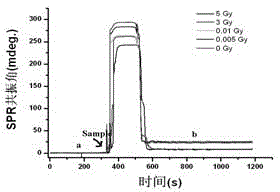HPRT (hypoxanthine phosphoribosyl transferase) body gene mutation detection method based on surface plasmon resonance
A surface plasmon and detection method technology, which is applied in the determination/inspection of microorganisms, biochemical equipment and methods, measurement devices, etc., to achieve the effects of intuitive experimental results, short time-consuming, and high sensitivity
- Summary
- Abstract
- Description
- Claims
- Application Information
AI Technical Summary
Problems solved by technology
Method used
Image
Examples
Embodiment 1
[0028] Based on surface plasmon resonance technology 60 Co gamma ray irradiation-induced HPRT somatic gene mutation detection method:
[0029] Part 1: SPR method to detect wild-type HPRT standard
[0030] 1. Preparation of 6-thioguanine-sensitive SPR gold membrane: 20 ul of cysteine (20 mM) was covered in Pirrahan solution (H 2 o 2 : Concentrated sulfuric acid = 3: 1) Wash the surface of the gold film (cleaning time is 15s), and then place the gold film in the dark overnight; after overnight, the gold film is thoroughly washed with distilled water to remove unbound cysteine, nitrogen Blow dry; the surface of the cysteine-modified gold film was covered with carboxymethyl dextran, N-hydroxysuccinimide (NHS) and 1-ethyl-3-(3-dimethylaminopropyl) A mixture of carbodiimide hydrochloride (EDC) (15 mM NHS, 75 mM EDC and 10 mg / ml carboxymethyl dextran) was placed in the dark for 2.5 hours. After 2.5 hours, rinse with distilled water and dry with nitrogen.
[0031] 2. Fix the ca...
PUM
 Login to View More
Login to View More Abstract
Description
Claims
Application Information
 Login to View More
Login to View More - R&D
- Intellectual Property
- Life Sciences
- Materials
- Tech Scout
- Unparalleled Data Quality
- Higher Quality Content
- 60% Fewer Hallucinations
Browse by: Latest US Patents, China's latest patents, Technical Efficacy Thesaurus, Application Domain, Technology Topic, Popular Technical Reports.
© 2025 PatSnap. All rights reserved.Legal|Privacy policy|Modern Slavery Act Transparency Statement|Sitemap|About US| Contact US: help@patsnap.com



